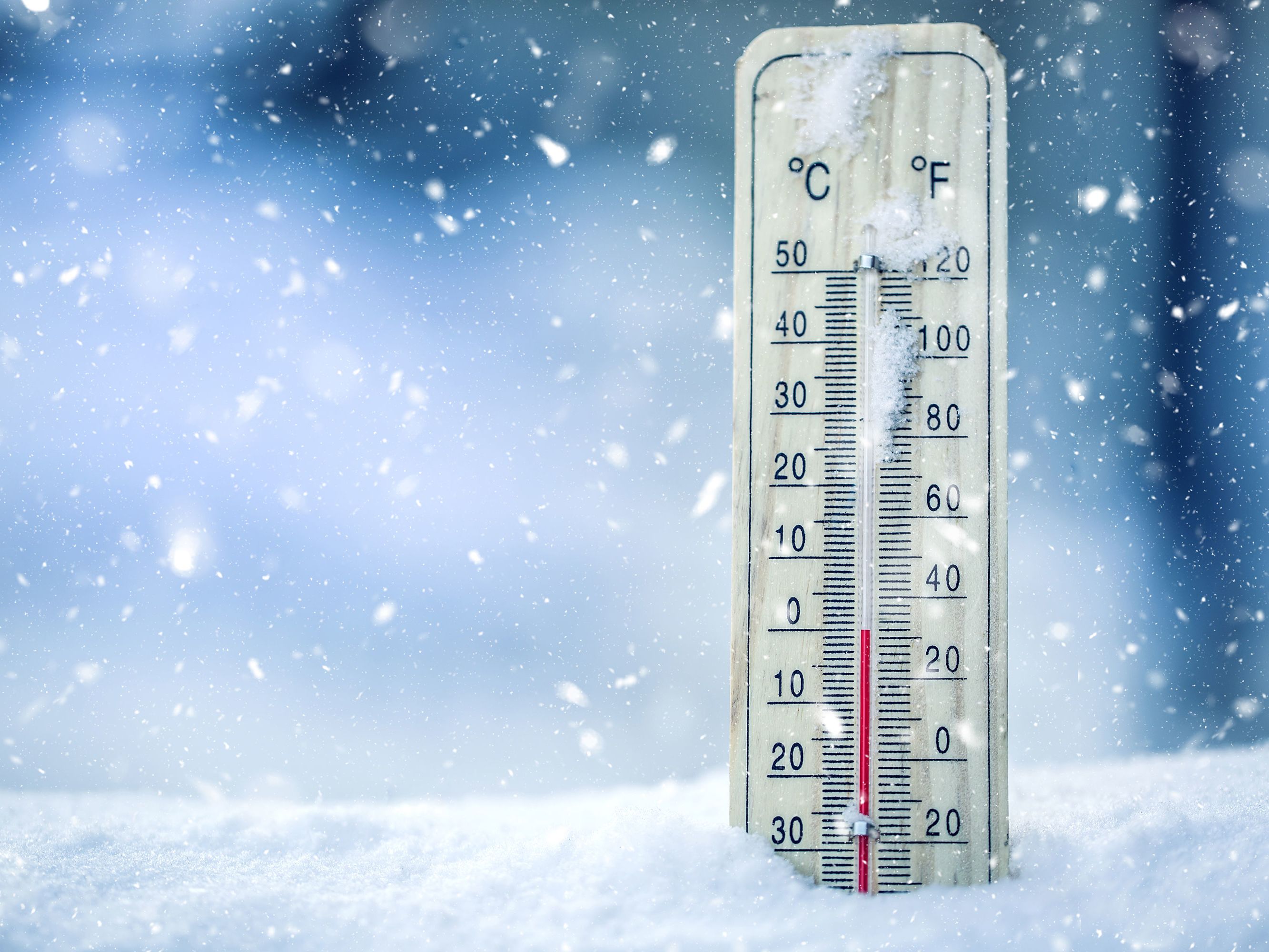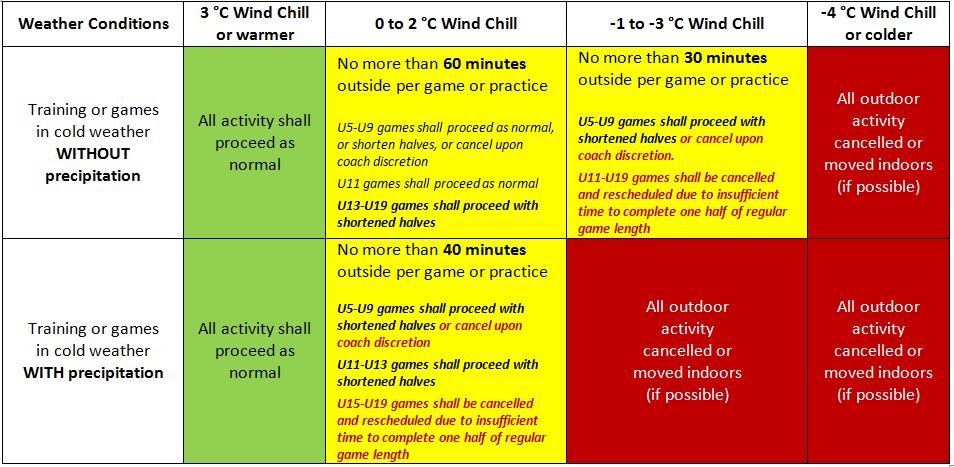Cold Weather Guidelines


COLD WEATHER SAFETY TIPS
| Dress Appropriate When temperatures drop and wind increases, the body loses heat more rapidly. It is important to dress appropriately when training or playing in cold weather. This also means to not overdress. Layering clothing is recommended and very effective and can be added or removed based on body temperature and changing environmental conditions, such as temperature and wind. Athletes who are not dressed adequately for the weather should not be allowed to participate for his or her safety. Never allow athletes to train alone in cold weather. Allow and encourage players to wear additional clothing such as: • Layers around body core to insulate, especially for those who are least active. • Long insulating pants with a nylon shell or windpant to block wind. • Layer long sleeve, sweatshirt, and jacket designed to insulate and block wind. • Gloves • Ear protection, toque, or hat • Wicking socks that do not hold moisture inside. • Cotton absorbs and holds moisture, wool is a better alternative. |
| Stay Dry Avoid sweating before going outside because your body will cool too quickly. Precipitation and damp conditions add to the risk of injury or illness during cold weather. Players, coaches and referees should recognize these factors and use additional caution to watch for potential cold injuries. If players do get wet during training or play, remove wet or saturated clothing and replace it with dry clothing. This becomes more important if the individual will remain out of play or anticipates standing around for a prolonged period of time. A hat, gloves and extra pair of socks can also keep extremities dry in case of snow or rain. |
| Fuel Up Cold exposure requires more energy from a body. Additional caloric intake may be required to support energy needs. |
| Stay Hydrated Cold weather often reduces our ability to recognize that we are becoming dehydrated and has similar hydration needs to warm weather activity. Athletes lose more water through respiration and sweat as the air is much drier than in warmer less windy months. Though the thirst reflex is not activated as quickly in cold, a conscious effort to hydrate before, during and after activity should be made. If you are thirsty you have already become dehydrated. Try putting warm or hot water in a water bottle so that your water doesn’t freeze when training for extended amounts of time outside. |
| Take Action If someone is suffering from a cold-related illness, get him or her into a warm location as soon as possible. Identify a nearby warming location before the start of training or play. During games provide blankets or other items for players to stay warm while they are on the bench and allow additional substitutions or warming breaks. |
| Wind Chill Pay attention to the wind chill temperature. Even prolonged exposure in relatively mild temperatures can lead to frostbite. |
COLD EXPOSURE CAN BE LIFE THREATENING - Know the Signs:
| Early recognition of cold stress is important. Shivering, a means for the body to generate heat, serves as an early warning sign. Excessive shivering contributes to fatigue and makes performance of motor skills more difficult. |
| Other signs include numbness, pain, swelling and redness in fingers and toes or a burning sensation of the ears, nose or any exposed flesh. Eyes may be red and watery, and athlete may complain of headache or dizziness. |
| As cold exposure continues, the core temperature drops. When the cold reaches the brain, a victim may exhibit sluggishness, poor judgment and may appear disoriented. Speech becomes slow and slurred, and movements become clumsy. If the participant wants to lie down and rest, the situation is a medical emergency and the emergency action plan should be activated. |
COMMON COLD RELATED ILLNESSES
| Frostnip Frostnip is a nonfreezing injury of the skin, usually of the fingers, toes, ears, cheeks, and chin. Redness, numbness and tingling are present, but no tissue freezing occurs. Symptoms develop when blood vessels supplying the affected tissues narrow because of the cold temperature. Do not rub affected area, but gently rewarm the skin with clothing or skin contact. |
| Chilblain A more significant nonfreezing injury of the skin, usually swelling of the exposed area is noted due to the rupturing of blood vessel walls in addition to the redness, numbness and tingling of frostnip. Do not rub affected area, but gently rewarm the skin with clothing or skin contact. |
| Frostbite Frostbite is what happens when skin and tissue actually begins freezing. It can cause numbness, tingling or stinging in the affected area. The skin may also lose its natural color, turning pale or bluish. Frostbite can permanently damage body tissue, leading to the loss of an extremity in severe cases. The most commonly affected areas for frostbite include: nose, ears, cheeks, chin, fingers and toes. Use body heat or warm (but not hot) water to begin warming the affected area. Recognize • Swelling/Edema • Redness or mottled gray skin appearance • Tingling or burning • Blisters • Numbness or loss of sensation Recover • Gradually rewarm affected area with warm water • Warning - Do not rub or massage the frostbitten area. This may actually increase the damage. Do not use heating pads, heat lamps or the heat of a stove, fireplace, or radiator for warming since affected areas are numb and can be easily burned. • Important - If any of the symptoms persist for longer than a few hours, seek medical attention from emergency department or physician. |
| Hypothermia Hypothermia is the result of your internal body temperature dropping to 95 degrees Fahrenheit (35 degrees Celsius) or less. It can be fatal if not detected promptly and treated properly. Hypothermia typically begins with feelings of intense cold, shivering and behavior which are more quiet and disengaged than normal. As the condition worsens, the individual seems confused, sleepy and may begin slurring speech. To begin treating hypothermia, start by warming the center of the individual’s body first. Make sure they are dry and cover them with layers of blankets, clothing, towels or whatever else is around to contain their body heat. Warm nonalcoholic beverages may also help increase body temperature. If hypothermia is suspected, get the on-site medical provider or call 911. Recognize • Shivering vigorously or suddenly not shivering • Increased blood pressure • Lethargy • Impaired mental function • Slurred speech Recover • Remove damp/wet clothing • Apply heat to the trunk of the body, not limbs • Provide warm fluids and food • Avoid applying friction massage to tissues • Warning - Do not use a hot shower or bath to treat hypothermia because it could cause the individual to go into shock. • Important - If symptoms persist seek medical attention from a physician or Emergency department. |
